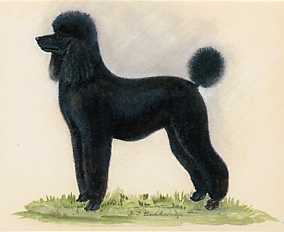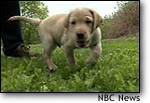Go Back
|
Go Back |
|
Every year the Douglas Pharmaceuticals Guide Dog Breeding Improvement Programme produces more than 100 puppies using natural and artificial breeding techniques.
 Breeds
of guide dogs
Breeds
of guide dogs
The Labrador Retriever is the most recognisable breed used for guide dog work. But a wider range of dogs is available for applicants to choose from.
The range of dogs includes Airedale Terrier, Australian Shepherd, Boxer, Belgium Shepherd, Border Collie, Curly Coated Retriever, Dalmatian, German Shepherd, Golden Retriever, Giant Schnauzer, and Standard Poodle.
Poodles are useful for people who are allergic to dog hair, and can't have a retriever.
The dog to the left is a black standard poodle.
Puppy Development
 At
seven to eight weeks the puppy enters the Champ Guide Dog Puppy
Development Programme.
At
seven to eight weeks the puppy enters the Champ Guide Dog Puppy
Development Programme.
It is cared for and socialised to deal with situations it will face as a guide dog.
Puppy walkers meet regularly to compare notes and they have the costs of caring for the puppy covered by Guide Dog Services.
Assessment and training
At 12-18 months the puppy is assessed for its potential as a guide dog, and if suitable, starts an in-depth training programme.
Dogs who do not qualify often go on to serve as companion dogs, custom dogs, are offered back to the puppy walkers or to selected homes.